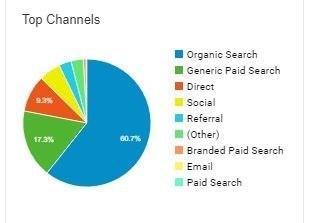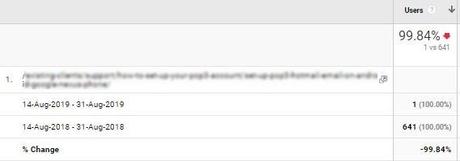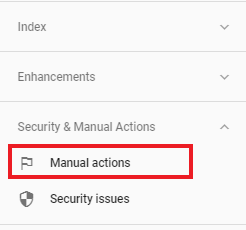Experiencing a sudden drop in website traffic can be very worrying. Have you been affected by a Google penalty, is there a Google algorithm update, or is the data being recorded incorrectly? This guide explains the procedure of identifying the cause of the traffic decrease and how to fix it.
Determine the Source of Traffic that has DecreasedThe first thing to do is to identify the cause of your traffic dropped. Human instinct tends to fear the worst, but often it might not be a reason to panic.

To determine exactly where your traffic is down, log into Google Analytics and navigate to the Acquisition report on the left of your screen.
Here you'll able to see a breakdown of the type of users that have stopped visiting your website.
⦁ Organic Search - Users who reach your website after clicking through from a search engine such as Google or Bing. This does not apply to clicks on Paid Ads.
⦁ Paid Search - Users who visit your website after clicking on a paid listing such as AdWords. These can be split up into 'Branded' paid searches, which are keywords that include the brand name, and 'Generic' paid searches, which are non-branded keywords.
⦁ Direct Traffic - Users who navigate directly to your website from their browser. This usually either by typing the URL into the search bar or visiting a bookmarked page.
⦁ Referral Traffic - Users who are directed to your website by clicking on a link on another website. For example, a directory or blog.
⦁ Email Traffic - Users who click a link to your website by clicking on a link in an email. Sometimes these appear as referral traffic so make sure you check both channels.
⦁ Social Traffic - Users who visit your website by clicking on a link on any popular social media platform such as Facebook or Twitter.
Examine each of these channels to find out exactly where the traffic has dropped. Once you have identified the source you can take action to help bring the traffic back to the website.
Below are the different steps you can take for each source of traffic.
⦁ Drop-in Traffic from All Sources
If all your website traffic has disappeared out of Google Analytics, this is probably because the tracking code is broken on your site.
Common reasons why this may happen are:
⦁ You have recently updated your theme header and have accidentally deleted part of the code.
⦁ You have added the GA tracking code directly into your theme's template and then updated the theme, deleting the code.
⦁ You have installed GA with a plugin that is broken.
You should test if your website has the tracking code installed and fix the problem.
Step 1 - Check the Code
Use the Chrome extension Tag Assistant to check if Google Analytics is successfully installed on your website.
Step 2 - Add Code
If the code is missing, install the Analytics code on the website. To get the tracking code, log in to Google Analytics and navigate to Admin > Property > Tracking Info > Tracking Code and follow the instructions.

⦁ Drop-in Traffic from Organic Sources
A drop in organic traffic can be one of the scariest things to see in Google Analytics. What if you got hit by a Google Penalty? Below are the steps you can take to identify and fix the cause of your decrease in traffic.

Step 1 - Identify Pages Affected
First of all, you need to find out if it's all your pages that have been affected or just a select few pages. If it is just a handful of pages that are affected may indicate a problem with either the index status or HTTP code of the page.

To see the traffic to each page, set the primary dimension in Google Analytics Acquisition reports to 'Landing Page'.
Below is an example of a page that has been identified as having a significant loss in traffic.
Step 2 - Check for Manual Penalties
If your overall organic traffic has dropped, there's always a risk that your website has been manually penalized by a Google reviewer. Even if you adhere to Google's quality guidelines, another business may have performed negative SEO on your website such as spammy link building to penalize you and harm your rankings.

To check to Manual actions, log into your Google Search Console account and navigate to Manual actions.
If your site has had a manual action applied, you will see a statement explaining why the action has been applied. Once you have fixed the problem you can request a review of your website to get the penalty removed.

Step 3 Check Index Status
One reason that your website may have lost significant amounts of organic traffic is that pages on the website have been deindexed. The best way to check this is through the index coverage report in Google Search Console.
If you see a sudden drop in the number of indexed pages then you have identified the issue.

You can also check if a page is indexed by searching site:www.yourdomain.com/your-page-path/ on Google.
If the URL is indexed it will show search results:
If it is not indexed then it will not show any results:
If you discover that pages on your website are deindexed you can follow steps to get your site indexed again by reading this guide.

Step 4 Check for Ranking Drops
Could be because Google has updated their algorithm.
Google is continually updating its algorithm, so it is normal for website rankings to change. The website that was perfectly optimized might not be once Google changes their criteria.
It could be because a competitor has boosted their SEO efforts and has overtaken you in the SERPs.
Look to consult an SEO specialist or increase your SEO budget to determine why your ranking has dropped and the steps you can take to recover it.
Some possible causes of rankings decreases are:
⦁ Lost links from authority websites
⦁ Failed redirects
⦁ Page load time has increased
Check out the full guide to Google ranking factors to see how you can improve your rankings.
If all your pages are indexed and have maintained their rankings, then it's possible that the volume of searches that the keyword receives has reduced over time.
Search habits and language change over time, it's possible that there has been an increase in users searching a variation of keyword that your website is optimized for.

Keyword search volumes can also drop if you have a page that is dedicated to a certain product and a newer model is released.
For example, if you have a product page ranking for the Samsung S9 and the Samsung S10 is released, S9 will receive fewer search terms because it is no longer the latest model.
A good way to check this is with Google Trends. On Google Trends you can type in a keyword and see how the search interest for the keyword has changed over time. In the example below, we can see how searches for the Samsung S9 peaked and declined over time.
This is also useful for determining whether a keyword has seasonal changes in search volume.
⦁ Drop-in Traffic from Paid Sources
If the only place your traffic has dropped is your PPC traffic, this will be because one of your campaigns has stopped running. This will be because either your payment has not been processed or your campaign has been turned off.
Step 5 - Check Google TrendsStep 1 - Check if Campaign is Paused
Log into your AdWords account to see if your campaign is still running. If your campaign is paused you can resume them by following these instructions.
If you are paying by credit card, check that your card has not expired and you still have enough funds to pay for the transaction.
If you have a drop in your social traffic follow these same steps.
⦁ Drop-in Direct Traffic
A drop in direct traffic often signals a change in either your offsite marketing or a change in your competitors' activity.
If your competitor has launched a high-profile marketing campaign, they could be stealing your website traffic.
If you have traditional marketing methods such as newspaper articles, radio advertising or billboards, it would be worth reviewing these to see if they are still effective forms of marketing.
⦁ Drop-in Email Traffic
A decrease in email traffic is also quite straightforward to deal with as you know there's a problem with users clicking links in your emails.
Step 1 - Check the Links
Make sure any links to your website that are included in your email templates have a valid URL and have the correct UTM codes.
Step 2 - Test Email
Send a test email to yourself to check that the template isn't broken or the email title hasn't changed. Broken HTML could lead to a decrease in engagement and traffic.
Quick Links:
Step 2 - Check Payment MethodConclusion! Has Your Traffic Decreased? Learn How to Diagnose and Fix the Problem With Google Analytics
Drops in traffic are scary and can come completely out of the blue. If you don't address immediately, they can result in huge decreases in revenue for your business as customers are no longer visiting your website.
The good thing is that this is often an easily identifiable and solvable issue. If you keep a cool head and follow these steps to diagnose the problem then you can retrieve any lost traffic in no time.
Josh Bruce is the SEO Specialist for UK Web Agency BFI. He has worked with some of the UK's leading brands including Vision Express and BOC. He has also has featured on many successful digital marketing blogs.


